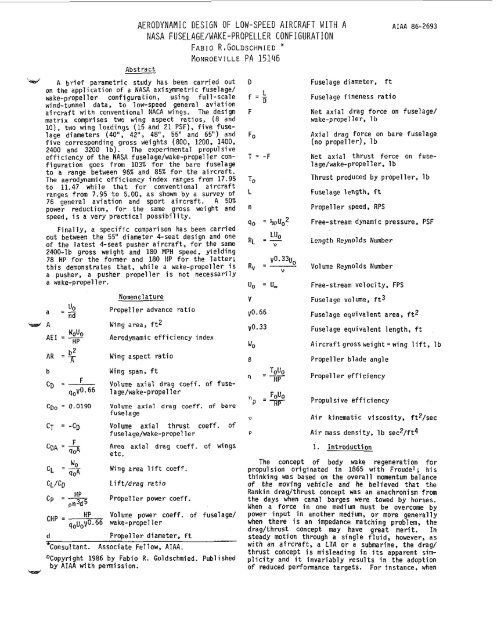Aerodynamic design of low-speed aircraft with a ... - CAFE Foundation
Aerodynamic design of low-speed aircraft with a ... - CAFE Foundation
Aerodynamic design of low-speed aircraft with a ... - CAFE Foundation
You also want an ePaper? Increase the reach of your titles
YUMPU automatically turns print PDFs into web optimized ePapers that Google loves.
AERODYNAMIC DESIGN OF LOW-SPEED AIRCRAFT WITH A<br />
NASA FUSELAGE/WAKE-PROPELLER CONFIGURATION<br />
FABIO R,GOLDSCHMIED *<br />
MONROEVILLE PA 15146<br />
Abstract<br />
4 A brief parametric study has been carried out<br />
on the application <strong>of</strong> a NASA axismmetric fuselage/<br />
wake-propel ler configuration , using f ul1 -Scale<br />
wind-tunnel data, to <strong>low</strong>-<strong>speed</strong> general aviation<br />
<strong>aircraft</strong> <strong>with</strong> conventional NACA wings. The <strong>design</strong><br />
matrix comprises two wing aspect ratios, (8 and<br />
IO), tHo wing loadings (15 and 21 PSF), five fuselage<br />
diameters (40", 42", 48", 55" and 65") and<br />
five corresponding gross weights (800, 1200, 1400,<br />
2400 and 3200 lb). The experimental propulsive<br />
efficiency <strong>of</strong> the NASA fuselagdwake-propeller configuration<br />
goes from 103% for the bare fuselage<br />
to a range between 96% and 85% for the <strong>aircraft</strong>.<br />
The aerodynamic efficiency index ranges from 17.95<br />
to 11.47 while that for conventional <strong>aircraft</strong><br />
ranges from 7.95 to 5.00, as shown by a survey Of<br />
76 general aviation and sport <strong>aircraft</strong>. A 50%<br />
power reduction, for the same gross weight and<br />
<strong>speed</strong>, is a very practical possibility.<br />
Finally, a specific comparison has been carried<br />
out between the 55" diameter 4-seat <strong>design</strong> and one<br />
<strong>of</strong> the latest 4-seat pusher <strong>aircraft</strong>, for the same<br />
2400-lb gross weight and 180 MPH <strong>speed</strong>, yielding<br />
78 HP for the former and 180 HP for the latter;<br />
this demonstrates that, while a wake-propeller iS<br />
a pusher, a pusher propeller is not necessarily<br />
a wake-propeller.<br />
Nomenclature<br />
Propeller advance ratio<br />
Wing area, ft2<br />
<strong>Aerodynamic</strong> efficiency index<br />
Wing aspect ratio<br />
Wing span, ft<br />
Volume axial drag coeff. <strong>of</strong> fuselage/wake-propel<br />
ler<br />
Volume axial drag coeff. <strong>of</strong> bare<br />
fuselage<br />
Volume axial thrust coeff. <strong>of</strong><br />
fusel age/wa ke-propel 1 er<br />
Area axial drag coeff. <strong>of</strong> Wings<br />
etc.<br />
Wing area lift coeff.<br />
Lift/drag ratio<br />
Propeller power coeff.<br />
HP Volume power coeff. <strong>of</strong> fuselage/<br />
CHP =<br />
90<br />
u ~0.66 wake-propeller<br />
0<br />
d<br />
Propeller diameter, ft<br />
*Consultant.<br />
Associate Fel<strong>low</strong>, AIAA.<br />
"Copyright 1986 by Fabio R.<br />
by AIAA <strong>with</strong> permission.<br />
Goldschmied. Published<br />
D<br />
f = D L<br />
F<br />
FO<br />
T = -F<br />
TO<br />
L<br />
n<br />
qo = kPU0 2<br />
RL -- LUO<br />
Rv<br />
=_- vo.33u0<br />
"<br />
u, = u,<br />
V<br />
YO. 66<br />
~0.33<br />
WO<br />
B<br />
TI<br />
q<br />
? --Ti-<br />
"<br />
TOUO<br />
HP<br />
FOUO<br />
Fuselage diameter,<br />
ft<br />
Fuselage fineness ratio<br />
AIAA 86-2693<br />
Net axial drag force on fuselage/<br />
wake-propel ler, 1 b<br />
Axial drag force on bare fuselage<br />
(no propeller), lb<br />
Net axial thrust force on fuselage/wake-propeller,<br />
lb<br />
Thrust produced by propeller, lb<br />
Fuselage length, ft<br />
Propeller <strong>speed</strong>, RPS<br />
Free-stream dynamic pressure, PSF<br />
Length Reynolds Number<br />
Volume Reynolds Number<br />
Free-stream velocity, FPS<br />
Fuselage volume, ft3<br />
Fuselage equivalent area, ftz<br />
Fuselage equivalent length, ft<br />
<strong>aircraft</strong> grossweight-wing lift, lb<br />
Propeller blade angle<br />
Propeller efficiency<br />
Propulsive efficiency<br />
Air kinematic viscosity. ftz/sec<br />
Air mass density, Ib sec2/ft4<br />
I. Introduction<br />
The concept <strong>of</strong> body wake regeneration for<br />
propulsion originated in 1865 <strong>with</strong> Froudel; his<br />
thinking was based on the overall momentum balance<br />
<strong>of</strong> the moving vehicle and he believed that the<br />
Rankin drag/thrust concept was an anachronism from<br />
the days when canal barges were towed by horses.<br />
When a force in one medium must be overcome by<br />
power input in another medium, or more generally<br />
when there is an impedance matching problem, the<br />
drag/thrust concept may have great merit. In<br />
steady motion through a single fluid, however, as<br />
<strong>with</strong> an <strong>aircraft</strong>, a LTA or a submarine, the drag/<br />
thrust concept is misleading in its apparent sim-<br />
plicity and it invariably results in the adoption<br />
<strong>of</strong> reduced performance targets. For instance, when

















